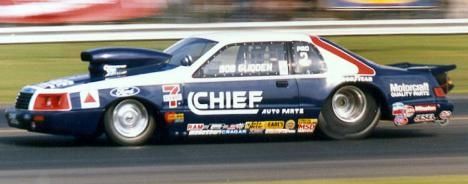Post by johnbalich on Mar 21, 2008 20:03:49 GMT -7
What are all those classes anyway?
This is going to be a quick study on NHRA (mostly) drag race classes. It will not cover EVERY variation and permutation and includes my personal prejudices. Hey it’s MY column, right?
By the way, do you HAVE to know all this stuff? Not really, but I have to admit it used to bug the heck out of me to see a nice car model or worse yet cover artwork on a model kit showing what is clearly a Superstocker with the designation A/A on the side of the car. If this info is helpful, use it. Otherwise, continue to enjoy without it.
LETS GET STARTED!
STOCK CLASS: A/S B/S..................... ALL THE WAY DOWN TO "N" STOCK. [ SUPERSTOCK SS/A SS/B SS/C SS/D SS/E]
We all know this one right? Actually Hot Rodders being what they are, they simply must tinker and modify. The traditional Stocker allows limited modifications. Maximum 8 cylinders, maximum 2 four barrel carbs, and all equipment must be available to the general public and produced in a minimum number of units for sale. The number was sometimes 500 units, 600 units or 1o00 units. The only reason John Q. Public could buy a Dodge Daytona (the wing car) is that Chrysler had to offer a minimum number of units for sale through dealerships to legalize them for racing, in this case for NASCAR.
Stock Classes were rated by advertised horsepower to weight ratios. NHRA assumed the car makers would always tout the maximum horsepower figures and to over-report would hurt their chances at the track. Never did they dream manufacturers would UNDER-REPORT, giving away potential horsepower bragging rights in exchange for drag race win bragging rights. Example; the Chrysler hemi was factory rated at 425 horsepower. NHRA quickly re- factored it to 500 HP. Designations go from HIghest classs A (least pound per horsepower) to lowest, MOST pounds per horsepower.
A/S is class"A" stock. SS means superstock. suffix "s' means stick, suffix "A" means automatic . Apparently to avoid spelling any unfortunate words, the SS comes first. SS/AA is super stock "A" Automatic. SS/SA reads superstock STICK "A'. SS/SB would mean Superstock Automatic class "B" and so on.
The principal differences between Stock and Super Stock are not obvious visually, Super Stockers were allowed altered camshafts, and Modified intake manifolds. The lowest Superstock classes also coincided with the highest Stock in power to weight ratios. If this is still confusing let me know. I can repeat what the rulebook (circa 1967) says word for word. Ill try tho on my own tho.. Any car with 1 power to weight ratio of 8.70-9.49 pounds per horsepower could be a class "A" stock or a class "D" Super Stock depending on cam and intake manifold. 9.50 pounds per horsepower would be a class "E" Super Stock or class "B" superstock depending on camshaft and manifold again.....Ok so far? One last thing: ANY car (of this type) with a power to weight ratio of LESS than 8.70 lbs per horsepower was automatically a Superstocker of class "C" "B" or "A", camshaft and intake manifold notwithstanding, tho altered cams and manifolds are certainly permitted. Suffice to say, the REALLY HOT Factory Stockers were Superstockers. Dual quad Hemis in full size sedans, Dual Quad 427 Fairlanes and Mustangs, 427 Chevelles and Camaros.
Ok one last try : The FASTEST (quickest) STOCKERS were slower than the MID RANGE and UPPER RANGE SUPERSTOCKERS. (ss/a ss/b ss/c) The SLOWEST SUPERSTOCKERS overlapped the FASTEST Stockers. Better? If not, take an aspirin and message me.
SPOTTING FEATURES: Looks like Dad's car looked in the sixties, but with cheater slicks and lots of decals. Almost always two door sedans, with an occasional station wagon thrown in for its shock value. Pretty neat names like LAWMAN, MAVERICK, PALADIN (all western shows of the era) RAMCHARGERS, MELROSE MISSILE and many more.
MODIFIED PRODUCTION: A/MP B/MP C/MP D/MP E/MP F/MP. Originally intended as a gap filler between Super Stock and Gas classes. Intended for the weekend warrior who might drive the during the week supposedly. Pretty much any engine modifications to the engine except fuel injection or supercharging, with no engine setback permitted. Engine swaps permitted. Designed for Joe Average hot rodder.
SPOTTING FEATURES: A toughie. Better check window decals for class designation!
FACTORY EXPERIMENTAL: A/FX B/FX AND C/: Looks pretty stock still. Front wheels often being relocated forward by as much as 2 per cent to improve weight distribution. Fuel Injection was by far the most common modification and spotting feature of these cars. The Ford Thunderbolts were famous AFX’ers of the era. The Thunderbolt matched the mighty 427 with the smallest for chassis it would fit in, albeit with some creative butchery. These cars were NOT built by Ford! They were finished off much like STEEDA or ROUSH Mustangs are now. AFX allowed ‘corporate’ engine swaps. Hence the 427 a Galaxie option, shoe horned into the Fairlane chassis. Some Falcon 427’s also existed, but I think they were really early Funny Cars. Typical entries: 427 Fairlanes, Hemi Dart.. LATER FX cars sported radical wheelbase alteration .. These don't appear in the 1967 rulebook, for reasons mentioned below, but mostly they were fuelie versions of the aforementiuoned cars. Often employed 'factory' fiberglass hoods and fenders, super light aluminum grilles and bumpers, sometimes acid dipped bodies, and a TWO PERCENT wheelbase alteration. When I first read this restriction as a kid of 14 or 15 I assumed the two percent was meant to be restrictive. I didn't do the math and realize two percent in a 115 inch wheelbase car was over two inches. Look closely at the early AFX'ers and noticed how the front tires scrape the front edge of wider than stock wheel wells. Moving the front tires forward greatly improved weight distribution.
SPOTTING FEATURES: Fuel Injection stacks thru the hood, and altered fron wheel position, mag racing wheels and slicks..
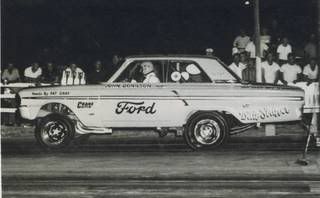
![]() i246.photobucket.com/albums/gg119/johnbalich/DRAG%20RACING/AFX%20and%20ALTRD%20WB/ramchargersagain.jpg
i246.photobucket.com/albums/gg119/johnbalich/DRAG%20RACING/AFX%20and%20ALTRD%20WB/ramchargersagain.jpg
The preceding photos do not display a Mopar prejudice (tho I may have one), but for a while Mopar Afx ers were EVERYWHERE, and therefore easy to find photos of.
SPORTS. A/SP B/SP C/SP Just what it says, Corvettes Cobras and the like
SPOTTING FEATURE: Is it a Corvette or Cobra that doesnt really look like a gasser? (You guessed)
MODIFIED SPORTS: AAM/SP AM/SP BM/SP CM/SP DM/SP. (Double letter "AA" means supercharged)
Supercharged vettes and Cobras as well as V-8 European Sports cars as well. Vettes and Cobras were later moved to Superstock and Gas Class according to amount of modifications done.
SPOTTING FEATURES: See above and add injectors or superchargers through the hood.
EXPERIMENTAL STOCK/FUNNY CAR: S/SX (oh great, now "S" means supercharged.) A/XS B/XS C/XS D/SX. Really the first legal NHRA FUNNY CARS. Guess NHRA couldnt quite yet see themselves using such a silly name for the class. This class SUPERCEDED FX and PRECEDED Funny Car. This are FX cars on drugs. (usually nitro)
This is really an interesting evolutionary story. Match racing was big in this era. Drivers were paid to show and compete in 2 out of 3 match races against specific opponents. For instance Ramchargers vs. dick Landy. These races were not subject to NHRA rules since they were not competing ‘in class’. Payouts at NHRA were quite low. Professional racers made their living by ‘appearance’ fees and exhibitions. The rule of this type racing was “Run What Ya Brung”. Modifications got wilder and wilder and the crowds loved it. It appears that dick Landy was the first to move the rear axle forward radically changing the weight distribution of the chassis. Other soon followed suit. Somewhere along the way some unknown track announcer referred to one of these incarnations as a FUNNY car. Somehow the name stuck. Eventually Jack Chrisman up the ante for all time when he showed at the Nationals with a full tube framed, supercharged, 427 Ford engine in his Mercury Comet body. Did I mention he ran it on Nitromethane? NHRA did not know what the heck to do with this car, and ended up classing it as a B Fuel Dragster! NHRA had a mess on its hands. The cars that had no class to compete in were becoming wildly popular with the fans. Worse yet, AHRA it’s only real competition, was running them as a legal class. Finally NHRA relented and Funny Car class as we know it began its evolution, tho called Experimental Stock as outlined above. The rules were interestingly vague if you ask me.
Example: Body: ".............................Must have a 1964 OR LATER COUPE OR SEDAN PRODUCED BY a "AUTOMOBILE MANUFACTURER". Yep, that means foreign as well. Fiberglass or aluminum duplicates of production bodies are permitted. BODIES MAY BE LENGTHENED." (how much?) Complete removal of windshield and what we now call A posts, was permitted to make 'roadster' Corvettes, Comets, Mustangs, you name it. Fenders were required but allowed to be 'modified" (how much?). I really think these rules were hastily adopted to allow a wide range of cars that were built WITHOUT rules. Heres why: Early Funny Cars were liable to be anything. Jeeps, Converted Corvette Roadsters, Broncos etc. Just as dragsters were stretching, builders realized stretching the rather short Funny Cars would improve both weight distribution as well as steering stability. Funny car builders started stretching the bodies of their cars to accommodate the chassis length. Ill show the evolution with pictures. Also, pressure from AHRA was mounting as they were sanctioning these cars.
SPOTTING FEATURES, EARLY FUNNIES: Supercharged Afx cars essentially. Gradually morphing into full race short wheelbase dragsters covered with a stretched Stock-Type body. Tops often slashed off to make roadsters. Common entries: Stretch Mustangs, Stretch Camaros, Stretch Challengers and Cudas. Oddball cars include Bronco funny Cars, Corvette Slash top roadsters, Corvair and even rear engine Corvair Funny Cars.
In my mind the FIRST "REAL" funny car, as it has all the basic features we know today; a tube frame a supercharged engine and runs on fuel. Ill have a history of this car alone soon. This is thew car Jack Chrisman brought to Indy nationals and NHRA had no idea what to call it so it raced in BB/Fuel Dragster.

How about a Nova Roadster?
[

Early funny car but looking good anyway:

Engines arent always in front!

GOLDEN ERA, POST MODERN ERA(Nostalgia): Stretch versions of familiar cars. (Funny Cars begin to slowly morph farther and farther from stock appearance.) Headers exit under splash panel area on the side of the body.
if a little stretch is good...........

once upon a time..............
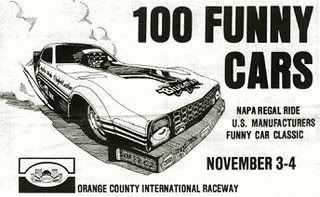
yes it says ONE HUNDRED. Another meet featured 124!
MODERN ERA:Easily spotted. Extreme wedge shape when viewed from side, extremely narrow 'cab' when viewed end on.
GAS COUPE AND SEDAN, AND STREET ROADSTER. A/G B/G C/G D/G E/G F/G H/G AA/G BB/G CC/G (Double letters designate supercharged classes. Other years supercharged cars go by A/GS B/GS C/GS.
Modified hot rods, traditionally Fat Fendered cars with no running boards but full fenders, headlights tailights etc. many engine combinations but Chrysler hemi takes precedence from about 1964 and on.
SPOTTING FEATURES:
GOLDEN ERA: High stance with straight tube front axles. CLASSES C/G D/G E/G tend to be 55 56 57 Chevies Fords, Pontiacs, etc.

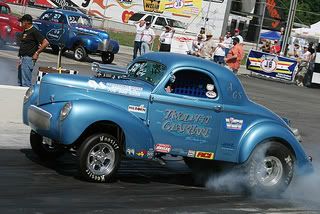

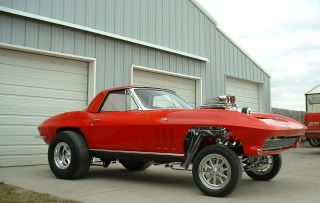

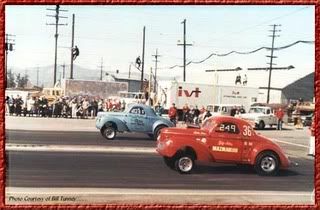
In spite of the full fenders, I think "big Al' ran as an altered. due to engine setback and the fact that the engine was an allison v-12 airplane engine!
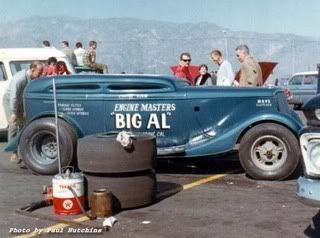
GOTTERDAMERUNG* ERA: Mustangs, Camaros and Cudas with standard wheelbases, tube frames and supercharged engines.
(* It means death of the Gods! lol) (notice how much they resemble Funny Cars. They are pretty Much Funny Cars on Gas. Embarassing isnt it?) Repeat after me: Gas is for washing parts, Alcohol is for drinking, Nitro is for Fuel!!) [ except gassers]
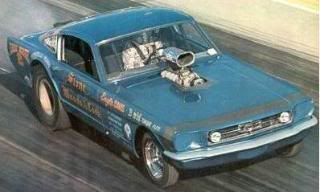

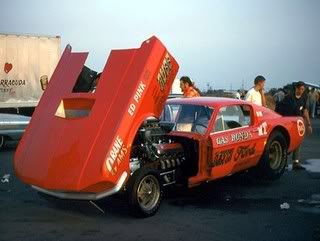
POST MODERN (nostalgia) ERA: Low slung, ground-scraping gassers with high rear wings.
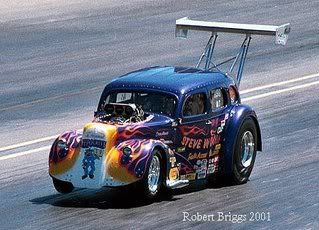
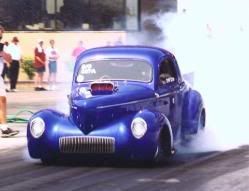
ALTERED COUPE AND ROADSTER: AA/FA, (on FUEL), AA/A (remember Double letters means supercharged) A/A B/A C/A
based on cubic inch /weight ratio.
Arguably the wildest class even to Race under NHRA sanction. Imagine a top fuel dragster with a wheelbase as short as ninety inches trying to go straight. Wild and crazy!! No fenders, minimal or no hoods, and drivers’ heads poking up through the rear window and tiny bodies, barely containing the running gear.
SPOTTING FEATURES:
EARLY TO MIDDLE ERA: Short wheelbase no fenders no runnin boards no bumpers no radiator minimal hood if any. Engines ride HIGH in the chassis Think ; "would Wild Willy Borsch look at home on this thing?? (see below)
the most famous AA/FF of all time. "The Winged Express" with Wild Willy himself at the controls. One of the few times you will see Willy with bothn hands on the wheel. ( I swear its true)
(This is at the Winternationals. No, Pembroke, that's NOT a burn out, just normal attitude for Willy.)

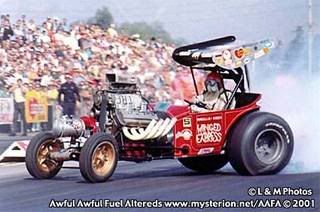
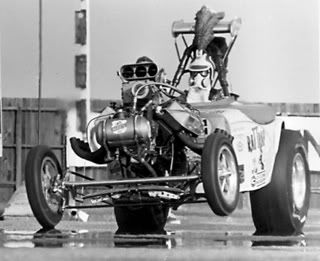
[Can any one tell me why the chassis is twisting the way it is in this picture. [The answer might fool you.] Not only why is it twisting but why in that direction? Also why do the cars try to go sideways??
NOTE below: Count the number of hands on the door sill and subtract that number from two. This is the pose Wild Willy is most known for.
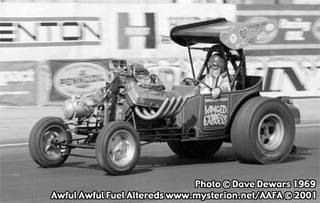
POST MODERN ERA: lengthened wheelbase with body stretched and streamlined.
Common entries: Model T roadster, Bantam roadster, Chopped Model T, Fiat Coupes.
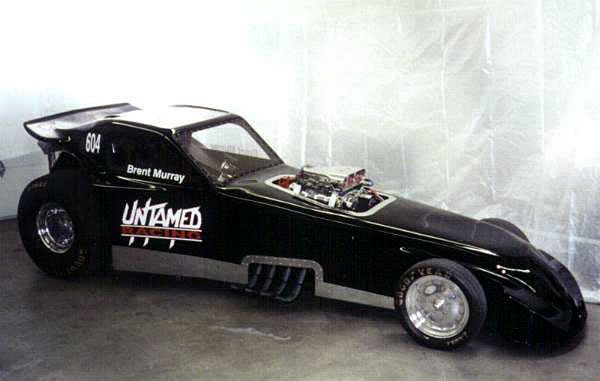

The 'vintage' Fuel Altereds were allowed only a 25 per cent engine set back, as measured from the front axle center. Lengthening the wheelbase by stretching the area in front of the engine automatically increases engine set back percentage. I will scan my rulebooks to try to determine what year this was liberalized. Can't really blame the NHRA, these things were borderline lethal. (what's not to love about that?)
COMPETITION COUPE AND ROADSTER : Another wild class. Take that altered and streecth the wheelbase back to dragster proportions, and drape a miniscule body over the rear slicks and there you have it. Some cars employed streamline fronts and some did not. Some have dragster bodies inside the “coupe” body, so by removing the outer shell they could compete directly as dragsters.
SPOTTING FEATURES: Extreme appearance. Long chassis with very small bodies.
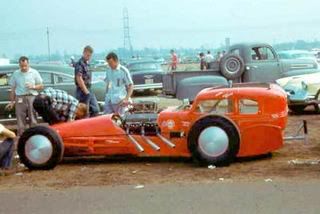
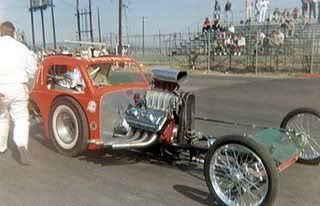
![]() i246.photobucket.com/albums/gg119/johnbalich/DRAG%
i246.photobucket.com/albums/gg119/johnbalich/DRAG%
20RACING/COMP%20CPE%20RDSTR/pat1.jpg[/IMG]
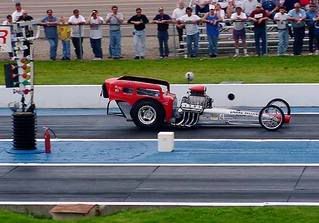
A comp roadster. (Races in same class)
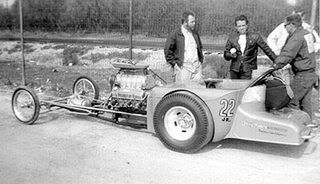
TOP GAS DRAGSTER: AA/D BB/D A/D B/D C/D D/D. Double lettes in prefix mena supercharged in 1967. Classes determined by CUBIC INCH to weigh ratio. Same as today’s dragsters, albeit all front ngine. Well, not all, but generally. When NHRA lifted its Nitro Ban, They ran both Top Gas and Top Fuel classes, and at the time they were equally favored by fans. Eventually top gas faded, only to reappear as Top Alcohol dragster. Top alcohol, both dragster and funny car are slower than their fuel counterparts and often serve as a training ground for fully professional classes. Some Alcohol dragsters only race part of the seasonal schedule in a regional area.
SPOTTING FEATURES:
PRE DAWN ERA (ANTIQUE): (1950-1952 or so: Extreme 'rail' design. Basically an engine on a flat frame, dtiver in a minimal seat with minimal or no rollbar or other apparent safety equipment.
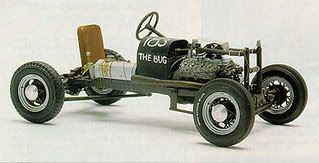

PRE CLASSIC: Slingshots begin to prevail, cars are still pretty funky and build-at-homes for sure.
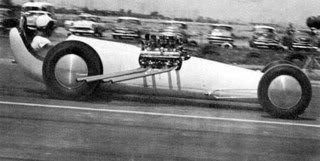
Still lots of room for innovation:
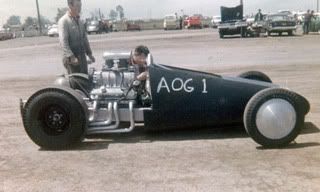

Bustle Bomb, the first car to do the 'impossible' and run over 150 mph in the quarter mile.
EARLY CLASSIC: Short wheelbase generally nicer looking cars, not alot of superchargers yet.
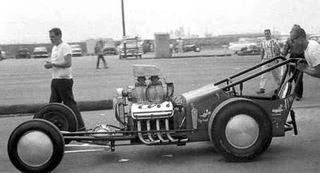

they can still be pretty tho... The Glass Slipper:
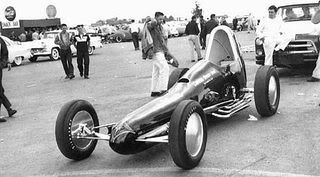
STILL MORE PROOF THAT INNOVATION WAS ONCE WELCOMED BY NHRA: (ALL TOP FUEL CARS)
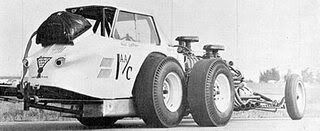
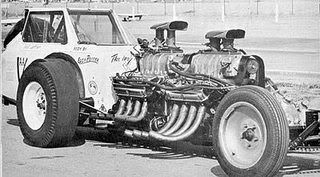
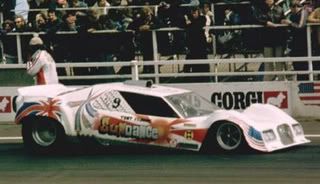
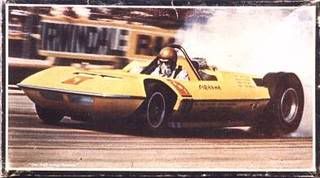
GOLDEN ERA: Slingshot design stretches, many cars employ front end enclosure and or wheel 'spats'. 'Zoomie' headers upswept pointing at rear slicks. Superchargers rule.Cars will often smoke the tires for entire run. Famous gas dragsters include the "Freight Train' dual inline chevy. .
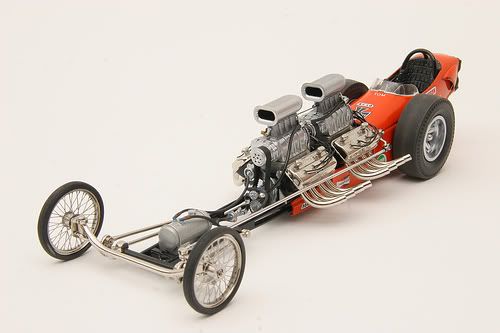
I know its a model, but its a great shot
TOP FUEL DRAGSTER: Implies no limits, though that concept has had to adjust to reality. Currently engine are limited to 500 cubic inches, one engine only, no airplane engines, jets or rockets, and rev limiters (NHRA mandated tamper proof black box.) set at around 8000 rpm. And nitromethane is limited to 90 percent. (I think the other ten per cent is methanol) The reason is speeds. Even with these limitations racers keep edging faster and faster. It is likely they would be going closer to 340 or more by now, and at what limit is it crazy dangerous to racers and fans? Some rear engine and other weird set-ups were once used, now rear engines are mandated for safety. The MODERN rear engine dragster was championed by Don Garlits himself, after an injury producing engine failure. Dragsters are considered somewhat safer than funny cars actually, since the engines are behind the driver any heat and smoke blows AWAY from the driver instead of into, and the body does not entrap all that hot unburned fuel in an explosion. Also the greater length allows the dragsters to aim straighter. Watching the Funny Cars in particular from the finish line you can see they really move around on the track, and that driving these beasts is a lot more than A point straight, mash the throttle and hang on proposition.
SPOTTING FEATURES:
GOLDEN ERA: LONG Slingshot design, some experimentation with rear engines, mostly unsuccessful, fully enclosed bodies unsuccessful, twin engines dissapear for most part, the Chrysler hemi begins its dominance, never to relinquish it. All Modern Funny Car and Dragster engines are variants of the Chrysler Hemi. Arguably the most beautiful full race machines ever built. "Elegant' is not to fancy a word to describe the best of these.
TRANSISITIONAL ERA: Don Garlits nearly killed and loses half of his foot in an engine clutch explosion and moves the engine behind the driver. After some testing adds the high wing. A new standard is born: LOOK FOR: rear engine, moderate chassis length, normally much less sleek than modern era.
MODERN ERA: Extreme length, rear engine, Large high wing to the rear. Supercharged Hemi engine. Unmistakeable profile.
Whew! thats alot of info, and it wil take a few readings to get all if it Im thinking. Ill be reviewing this article and correcting it over time for typos etc. PLEASE, any one with info to add let us know. The idea isnt for me to be the authority, the idea is to share the info with as many of you as are interested. Photos will definitely be attached but i wanted to get this up online without further delay.
The trickiest part of this article is by far the evolution of Superstock into Factory Experimental into Experimental Stock into Funny cars. Calling a car one or the other is often A judgement call. Rules were vague and seemingly flexible. Often the rules were written to cover the cars being built and not vice versa. Basically, racers were stealing the show!

This is going to be a quick study on NHRA (mostly) drag race classes. It will not cover EVERY variation and permutation and includes my personal prejudices. Hey it’s MY column, right?
By the way, do you HAVE to know all this stuff? Not really, but I have to admit it used to bug the heck out of me to see a nice car model or worse yet cover artwork on a model kit showing what is clearly a Superstocker with the designation A/A on the side of the car. If this info is helpful, use it. Otherwise, continue to enjoy without it.
LETS GET STARTED!
STOCK CLASS: A/S B/S..................... ALL THE WAY DOWN TO "N" STOCK. [ SUPERSTOCK SS/A SS/B SS/C SS/D SS/E]
We all know this one right? Actually Hot Rodders being what they are, they simply must tinker and modify. The traditional Stocker allows limited modifications. Maximum 8 cylinders, maximum 2 four barrel carbs, and all equipment must be available to the general public and produced in a minimum number of units for sale. The number was sometimes 500 units, 600 units or 1o00 units. The only reason John Q. Public could buy a Dodge Daytona (the wing car) is that Chrysler had to offer a minimum number of units for sale through dealerships to legalize them for racing, in this case for NASCAR.
Stock Classes were rated by advertised horsepower to weight ratios. NHRA assumed the car makers would always tout the maximum horsepower figures and to over-report would hurt their chances at the track. Never did they dream manufacturers would UNDER-REPORT, giving away potential horsepower bragging rights in exchange for drag race win bragging rights. Example; the Chrysler hemi was factory rated at 425 horsepower. NHRA quickly re- factored it to 500 HP. Designations go from HIghest classs A (least pound per horsepower) to lowest, MOST pounds per horsepower.
A/S is class"A" stock. SS means superstock. suffix "s' means stick, suffix "A" means automatic . Apparently to avoid spelling any unfortunate words, the SS comes first. SS/AA is super stock "A" Automatic. SS/SA reads superstock STICK "A'. SS/SB would mean Superstock Automatic class "B" and so on.
The principal differences between Stock and Super Stock are not obvious visually, Super Stockers were allowed altered camshafts, and Modified intake manifolds. The lowest Superstock classes also coincided with the highest Stock in power to weight ratios. If this is still confusing let me know. I can repeat what the rulebook (circa 1967) says word for word. Ill try tho on my own tho.. Any car with 1 power to weight ratio of 8.70-9.49 pounds per horsepower could be a class "A" stock or a class "D" Super Stock depending on cam and intake manifold. 9.50 pounds per horsepower would be a class "E" Super Stock or class "B" superstock depending on camshaft and manifold again.....Ok so far? One last thing: ANY car (of this type) with a power to weight ratio of LESS than 8.70 lbs per horsepower was automatically a Superstocker of class "C" "B" or "A", camshaft and intake manifold notwithstanding, tho altered cams and manifolds are certainly permitted. Suffice to say, the REALLY HOT Factory Stockers were Superstockers. Dual quad Hemis in full size sedans, Dual Quad 427 Fairlanes and Mustangs, 427 Chevelles and Camaros.
Ok one last try : The FASTEST (quickest) STOCKERS were slower than the MID RANGE and UPPER RANGE SUPERSTOCKERS. (ss/a ss/b ss/c) The SLOWEST SUPERSTOCKERS overlapped the FASTEST Stockers. Better? If not, take an aspirin and message me.
SPOTTING FEATURES: Looks like Dad's car looked in the sixties, but with cheater slicks and lots of decals. Almost always two door sedans, with an occasional station wagon thrown in for its shock value. Pretty neat names like LAWMAN, MAVERICK, PALADIN (all western shows of the era) RAMCHARGERS, MELROSE MISSILE and many more.
MODIFIED PRODUCTION: A/MP B/MP C/MP D/MP E/MP F/MP. Originally intended as a gap filler between Super Stock and Gas classes. Intended for the weekend warrior who might drive the during the week supposedly. Pretty much any engine modifications to the engine except fuel injection or supercharging, with no engine setback permitted. Engine swaps permitted. Designed for Joe Average hot rodder.
SPOTTING FEATURES: A toughie. Better check window decals for class designation!
FACTORY EXPERIMENTAL: A/FX B/FX AND C/: Looks pretty stock still. Front wheels often being relocated forward by as much as 2 per cent to improve weight distribution. Fuel Injection was by far the most common modification and spotting feature of these cars. The Ford Thunderbolts were famous AFX’ers of the era. The Thunderbolt matched the mighty 427 with the smallest for chassis it would fit in, albeit with some creative butchery. These cars were NOT built by Ford! They were finished off much like STEEDA or ROUSH Mustangs are now. AFX allowed ‘corporate’ engine swaps. Hence the 427 a Galaxie option, shoe horned into the Fairlane chassis. Some Falcon 427’s also existed, but I think they were really early Funny Cars. Typical entries: 427 Fairlanes, Hemi Dart.. LATER FX cars sported radical wheelbase alteration .. These don't appear in the 1967 rulebook, for reasons mentioned below, but mostly they were fuelie versions of the aforementiuoned cars. Often employed 'factory' fiberglass hoods and fenders, super light aluminum grilles and bumpers, sometimes acid dipped bodies, and a TWO PERCENT wheelbase alteration. When I first read this restriction as a kid of 14 or 15 I assumed the two percent was meant to be restrictive. I didn't do the math and realize two percent in a 115 inch wheelbase car was over two inches. Look closely at the early AFX'ers and noticed how the front tires scrape the front edge of wider than stock wheel wells. Moving the front tires forward greatly improved weight distribution.
SPOTTING FEATURES: Fuel Injection stacks thru the hood, and altered fron wheel position, mag racing wheels and slicks..

The preceding photos do not display a Mopar prejudice (tho I may have one), but for a while Mopar Afx ers were EVERYWHERE, and therefore easy to find photos of.
SPORTS. A/SP B/SP C/SP Just what it says, Corvettes Cobras and the like
SPOTTING FEATURE: Is it a Corvette or Cobra that doesnt really look like a gasser? (You guessed)
MODIFIED SPORTS: AAM/SP AM/SP BM/SP CM/SP DM/SP. (Double letter "AA" means supercharged)
Supercharged vettes and Cobras as well as V-8 European Sports cars as well. Vettes and Cobras were later moved to Superstock and Gas Class according to amount of modifications done.
SPOTTING FEATURES: See above and add injectors or superchargers through the hood.
EXPERIMENTAL STOCK/FUNNY CAR: S/SX (oh great, now "S" means supercharged.) A/XS B/XS C/XS D/SX. Really the first legal NHRA FUNNY CARS. Guess NHRA couldnt quite yet see themselves using such a silly name for the class. This class SUPERCEDED FX and PRECEDED Funny Car. This are FX cars on drugs. (usually nitro)
This is really an interesting evolutionary story. Match racing was big in this era. Drivers were paid to show and compete in 2 out of 3 match races against specific opponents. For instance Ramchargers vs. dick Landy. These races were not subject to NHRA rules since they were not competing ‘in class’. Payouts at NHRA were quite low. Professional racers made their living by ‘appearance’ fees and exhibitions. The rule of this type racing was “Run What Ya Brung”. Modifications got wilder and wilder and the crowds loved it. It appears that dick Landy was the first to move the rear axle forward radically changing the weight distribution of the chassis. Other soon followed suit. Somewhere along the way some unknown track announcer referred to one of these incarnations as a FUNNY car. Somehow the name stuck. Eventually Jack Chrisman up the ante for all time when he showed at the Nationals with a full tube framed, supercharged, 427 Ford engine in his Mercury Comet body. Did I mention he ran it on Nitromethane? NHRA did not know what the heck to do with this car, and ended up classing it as a B Fuel Dragster! NHRA had a mess on its hands. The cars that had no class to compete in were becoming wildly popular with the fans. Worse yet, AHRA it’s only real competition, was running them as a legal class. Finally NHRA relented and Funny Car class as we know it began its evolution, tho called Experimental Stock as outlined above. The rules were interestingly vague if you ask me.
Example: Body: ".............................Must have a 1964 OR LATER COUPE OR SEDAN PRODUCED BY a "AUTOMOBILE MANUFACTURER". Yep, that means foreign as well. Fiberglass or aluminum duplicates of production bodies are permitted. BODIES MAY BE LENGTHENED." (how much?) Complete removal of windshield and what we now call A posts, was permitted to make 'roadster' Corvettes, Comets, Mustangs, you name it. Fenders were required but allowed to be 'modified" (how much?). I really think these rules were hastily adopted to allow a wide range of cars that were built WITHOUT rules. Heres why: Early Funny Cars were liable to be anything. Jeeps, Converted Corvette Roadsters, Broncos etc. Just as dragsters were stretching, builders realized stretching the rather short Funny Cars would improve both weight distribution as well as steering stability. Funny car builders started stretching the bodies of their cars to accommodate the chassis length. Ill show the evolution with pictures. Also, pressure from AHRA was mounting as they were sanctioning these cars.
SPOTTING FEATURES, EARLY FUNNIES: Supercharged Afx cars essentially. Gradually morphing into full race short wheelbase dragsters covered with a stretched Stock-Type body. Tops often slashed off to make roadsters. Common entries: Stretch Mustangs, Stretch Camaros, Stretch Challengers and Cudas. Oddball cars include Bronco funny Cars, Corvette Slash top roadsters, Corvair and even rear engine Corvair Funny Cars.
In my mind the FIRST "REAL" funny car, as it has all the basic features we know today; a tube frame a supercharged engine and runs on fuel. Ill have a history of this car alone soon. This is thew car Jack Chrisman brought to Indy nationals and NHRA had no idea what to call it so it raced in BB/Fuel Dragster.

How about a Nova Roadster?
[


Early funny car but looking good anyway:

Engines arent always in front!

GOLDEN ERA, POST MODERN ERA(Nostalgia): Stretch versions of familiar cars. (Funny Cars begin to slowly morph farther and farther from stock appearance.) Headers exit under splash panel area on the side of the body.
if a little stretch is good...........

once upon a time..............

yes it says ONE HUNDRED. Another meet featured 124!
MODERN ERA:Easily spotted. Extreme wedge shape when viewed from side, extremely narrow 'cab' when viewed end on.
GAS COUPE AND SEDAN, AND STREET ROADSTER. A/G B/G C/G D/G E/G F/G H/G AA/G BB/G CC/G (Double letters designate supercharged classes. Other years supercharged cars go by A/GS B/GS C/GS.
Modified hot rods, traditionally Fat Fendered cars with no running boards but full fenders, headlights tailights etc. many engine combinations but Chrysler hemi takes precedence from about 1964 and on.
SPOTTING FEATURES:
GOLDEN ERA: High stance with straight tube front axles. CLASSES C/G D/G E/G tend to be 55 56 57 Chevies Fords, Pontiacs, etc.






In spite of the full fenders, I think "big Al' ran as an altered. due to engine setback and the fact that the engine was an allison v-12 airplane engine!

GOTTERDAMERUNG* ERA: Mustangs, Camaros and Cudas with standard wheelbases, tube frames and supercharged engines.
(* It means death of the Gods! lol) (notice how much they resemble Funny Cars. They are pretty Much Funny Cars on Gas. Embarassing isnt it?) Repeat after me: Gas is for washing parts, Alcohol is for drinking, Nitro is for Fuel!!) [ except gassers]



POST MODERN (nostalgia) ERA: Low slung, ground-scraping gassers with high rear wings.


ALTERED COUPE AND ROADSTER: AA/FA, (on FUEL), AA/A (remember Double letters means supercharged) A/A B/A C/A
based on cubic inch /weight ratio.
Arguably the wildest class even to Race under NHRA sanction. Imagine a top fuel dragster with a wheelbase as short as ninety inches trying to go straight. Wild and crazy!! No fenders, minimal or no hoods, and drivers’ heads poking up through the rear window and tiny bodies, barely containing the running gear.
SPOTTING FEATURES:
EARLY TO MIDDLE ERA: Short wheelbase no fenders no runnin boards no bumpers no radiator minimal hood if any. Engines ride HIGH in the chassis Think ; "would Wild Willy Borsch look at home on this thing?? (see below)
the most famous AA/FF of all time. "The Winged Express" with Wild Willy himself at the controls. One of the few times you will see Willy with bothn hands on the wheel. ( I swear its true)
(This is at the Winternationals. No, Pembroke, that's NOT a burn out, just normal attitude for Willy.)



[Can any one tell me why the chassis is twisting the way it is in this picture. [The answer might fool you.] Not only why is it twisting but why in that direction? Also why do the cars try to go sideways??
NOTE below: Count the number of hands on the door sill and subtract that number from two. This is the pose Wild Willy is most known for.

POST MODERN ERA: lengthened wheelbase with body stretched and streamlined.
Common entries: Model T roadster, Bantam roadster, Chopped Model T, Fiat Coupes.


The 'vintage' Fuel Altereds were allowed only a 25 per cent engine set back, as measured from the front axle center. Lengthening the wheelbase by stretching the area in front of the engine automatically increases engine set back percentage. I will scan my rulebooks to try to determine what year this was liberalized. Can't really blame the NHRA, these things were borderline lethal. (what's not to love about that?)
COMPETITION COUPE AND ROADSTER : Another wild class. Take that altered and streecth the wheelbase back to dragster proportions, and drape a miniscule body over the rear slicks and there you have it. Some cars employed streamline fronts and some did not. Some have dragster bodies inside the “coupe” body, so by removing the outer shell they could compete directly as dragsters.
SPOTTING FEATURES: Extreme appearance. Long chassis with very small bodies.


20RACING/COMP%20CPE%20RDSTR/pat1.jpg[/IMG]

A comp roadster. (Races in same class)

TOP GAS DRAGSTER: AA/D BB/D A/D B/D C/D D/D. Double lettes in prefix mena supercharged in 1967. Classes determined by CUBIC INCH to weigh ratio. Same as today’s dragsters, albeit all front ngine. Well, not all, but generally. When NHRA lifted its Nitro Ban, They ran both Top Gas and Top Fuel classes, and at the time they were equally favored by fans. Eventually top gas faded, only to reappear as Top Alcohol dragster. Top alcohol, both dragster and funny car are slower than their fuel counterparts and often serve as a training ground for fully professional classes. Some Alcohol dragsters only race part of the seasonal schedule in a regional area.
SPOTTING FEATURES:
PRE DAWN ERA (ANTIQUE): (1950-1952 or so: Extreme 'rail' design. Basically an engine on a flat frame, dtiver in a minimal seat with minimal or no rollbar or other apparent safety equipment.


PRE CLASSIC: Slingshots begin to prevail, cars are still pretty funky and build-at-homes for sure.

Still lots of room for innovation:


Bustle Bomb, the first car to do the 'impossible' and run over 150 mph in the quarter mile.
EARLY CLASSIC: Short wheelbase generally nicer looking cars, not alot of superchargers yet.


they can still be pretty tho... The Glass Slipper:

STILL MORE PROOF THAT INNOVATION WAS ONCE WELCOMED BY NHRA: (ALL TOP FUEL CARS)




GOLDEN ERA: Slingshot design stretches, many cars employ front end enclosure and or wheel 'spats'. 'Zoomie' headers upswept pointing at rear slicks. Superchargers rule.Cars will often smoke the tires for entire run. Famous gas dragsters include the "Freight Train' dual inline chevy. .

I know its a model, but its a great shot
TOP FUEL DRAGSTER: Implies no limits, though that concept has had to adjust to reality. Currently engine are limited to 500 cubic inches, one engine only, no airplane engines, jets or rockets, and rev limiters (NHRA mandated tamper proof black box.) set at around 8000 rpm. And nitromethane is limited to 90 percent. (I think the other ten per cent is methanol) The reason is speeds. Even with these limitations racers keep edging faster and faster. It is likely they would be going closer to 340 or more by now, and at what limit is it crazy dangerous to racers and fans? Some rear engine and other weird set-ups were once used, now rear engines are mandated for safety. The MODERN rear engine dragster was championed by Don Garlits himself, after an injury producing engine failure. Dragsters are considered somewhat safer than funny cars actually, since the engines are behind the driver any heat and smoke blows AWAY from the driver instead of into, and the body does not entrap all that hot unburned fuel in an explosion. Also the greater length allows the dragsters to aim straighter. Watching the Funny Cars in particular from the finish line you can see they really move around on the track, and that driving these beasts is a lot more than A point straight, mash the throttle and hang on proposition.
SPOTTING FEATURES:
GOLDEN ERA: LONG Slingshot design, some experimentation with rear engines, mostly unsuccessful, fully enclosed bodies unsuccessful, twin engines dissapear for most part, the Chrysler hemi begins its dominance, never to relinquish it. All Modern Funny Car and Dragster engines are variants of the Chrysler Hemi. Arguably the most beautiful full race machines ever built. "Elegant' is not to fancy a word to describe the best of these.
TRANSISITIONAL ERA: Don Garlits nearly killed and loses half of his foot in an engine clutch explosion and moves the engine behind the driver. After some testing adds the high wing. A new standard is born: LOOK FOR: rear engine, moderate chassis length, normally much less sleek than modern era.
MODERN ERA: Extreme length, rear engine, Large high wing to the rear. Supercharged Hemi engine. Unmistakeable profile.
Whew! thats alot of info, and it wil take a few readings to get all if it Im thinking. Ill be reviewing this article and correcting it over time for typos etc. PLEASE, any one with info to add let us know. The idea isnt for me to be the authority, the idea is to share the info with as many of you as are interested. Photos will definitely be attached but i wanted to get this up online without further delay.
The trickiest part of this article is by far the evolution of Superstock into Factory Experimental into Experimental Stock into Funny cars. Calling a car one or the other is often A judgement call. Rules were vague and seemingly flexible. Often the rules were written to cover the cars being built and not vice versa. Basically, racers were stealing the show!




